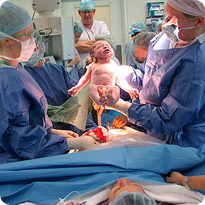|
C-section: What You Need to KnowC-sections are a fact of life for birthing women these days. Whether you're planning on having one, or planning on avoiding one, you need to know what they entail.What exactly is a c-section? It stands for cesarean section (sometimes spelled caesarean section), and it is a surgical incision (cut) made on your lower stomach, usually horizontally along your bikini line. The incision is between 4-10 inches long, and cuts through the skin, the abdominal connective tissues and muscles under the skin, and through the wall of the uterus to give the doctors access to the baby. Once the baby and the placenta are removed from the uterus, the layers are then surgically sewed (sutured) back together. Read more about the cesarean section procedure, and what exactly you can expect during surgery. It may also be a good idea to see what the surgery looks like by looking at some cesarean section videos. 
How likely is it that you'll need a cesarean? That actually depends largely on the policies of the institution where you'll be giving birth, as well as on the practices of the care provider you choose. Yes, that means that your choice of hospital has more to do with whether you'll end up with a cesarean than events in your labor. Crazy, isn't it? So make sure you research both the place where you'll be giving birth, and your provider. Be sure to ask about their cesarean rates. In the US, the nation-wide average cesarean rate in hospitals is around 33% as of 2011. That means that 1 out of 3 women will have a cesarean in the US if they give birth in a hospital. And some hospitals have caesarean section rates over 70%! What's wrong with these numbers, you ask? The problem is that it is too high. The "magic number" above which more c-sections begin resulting in more maternal and neonatal death, is 15%. So having a cesarean rate of 33% in the US means that mothers and babies are being unnecessarily injured or die as a result of unnecessary surgeries. If your hospital has a high c-section rate, do not kid yourself that you will be the exception rather than the rule. If avoiding a caesarean section is important to you, and you find out that your hospital has a high rate, consider switching institutions! Click here for a list of c-section rates by state and by hospital in the United States. Can you avoid a c-section? Yes, you can avoid a cesarean, especially an unnecessary cesarean, otherwise known as a unnecesarean. Here are my top tips for avoiding a c-section:
Can you request a cesarean? Yes, you can. An elective c-section is usually discouraged by medical professional societies, but common practice is that if the mother is really set on having elective surgery, a reason will be found to perform it. More often, a hesitant mother will be tipped toward consenting to it because her doctor openly or subtly steers her toward that choice. However, you should be aware that an elective c-section for no medical reason has more risks to both you and your baby than a vaginal delivery. Usually, if a pregnant woman is thinking of requesting a cesarean, it is because she finds it less frightening and better controlled than vaginal birth. It may appear so, and it may also be more convenient and a safer choice for her doctor, but the fact remains that a vaginal birth is safer than a cesarean birth for healthy women with uncomplicated pregnancies. Childbirth education can go a long way toward preparing you for what to expect during labor and childbirth, and thus making it less frightening. A vaginal birth is better for you and your baby, and it has the potential to be a truly wonderful, blissful experience. Why not give it a try? What is it like after a c-section? A cesarean section is major abdominal surgery. You know how they tell folks who had their appendix taken out to rest and not overexert themselves after their surgery? Well, that won't be you. After a cesarean, you'll be feeling just as crappy as anybody else with major abdominal surgery, the difference is you'll also have a newborn baby to take care of. Read the article on c-section recovery for what to expect post-surgery. Can you have a vaginal birth after a cesarean? Yes, definitely! (Depending on the reasons for your first cesarean, of course. If you had to have a cesarean due to some kind of illness that still remains in subsequent pregnancies, than probably not.) If you had a cesarean in the past for things like failed inductions, failure to progress, a breech baby, etc, it is most certainly possible to have a vaginal birth after a cesarean, otherwise known as a VBAC. In fact, the current recommendation by the American Congress of Obstetricians and Gynecologists (ACOG) is that a trial of labor (TOLAC) is recommended after cesareans rather than a routine repeat cesarean. All the tips I mentioned above for avoiding a cesarean apply double for a VBAC.
|